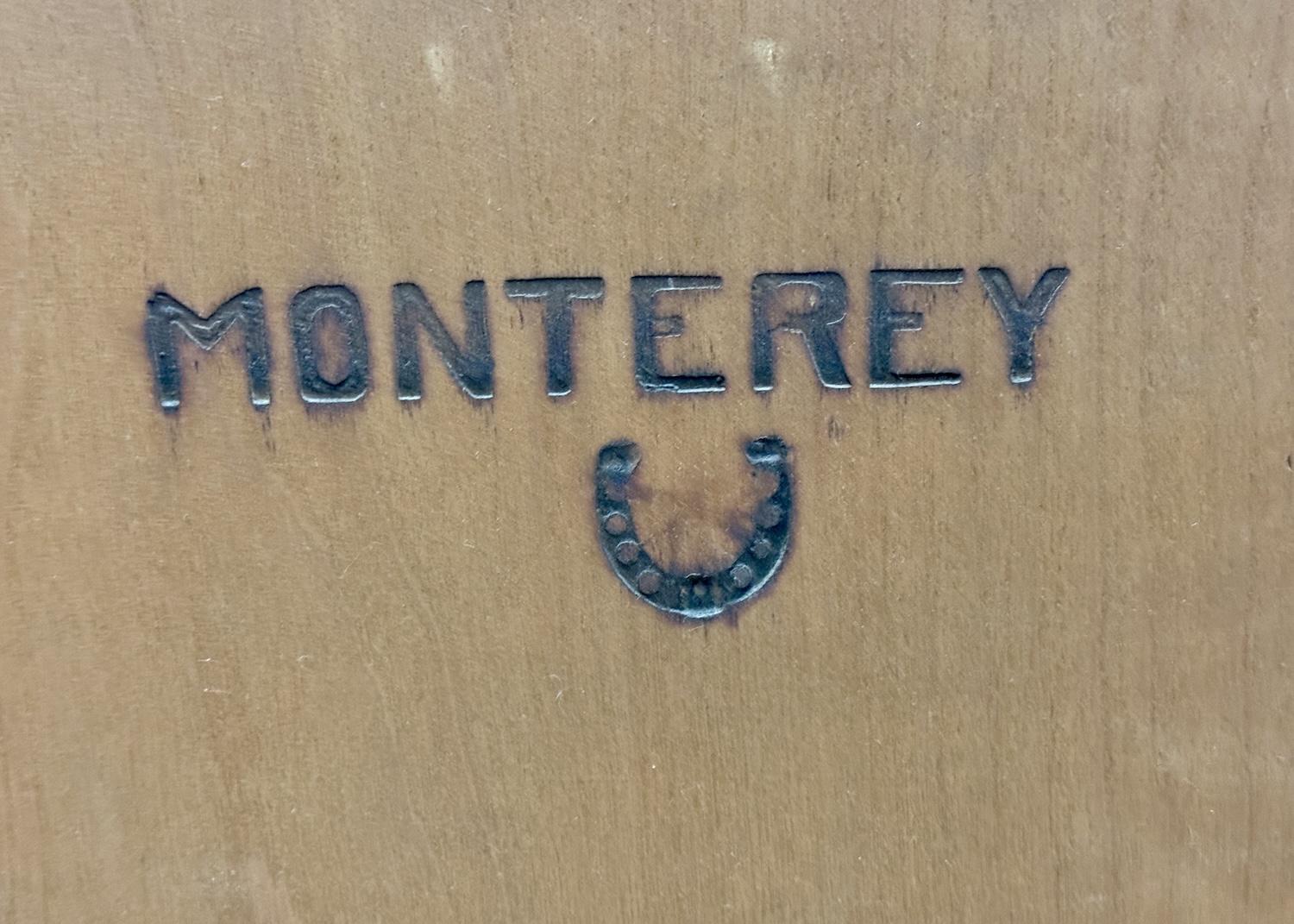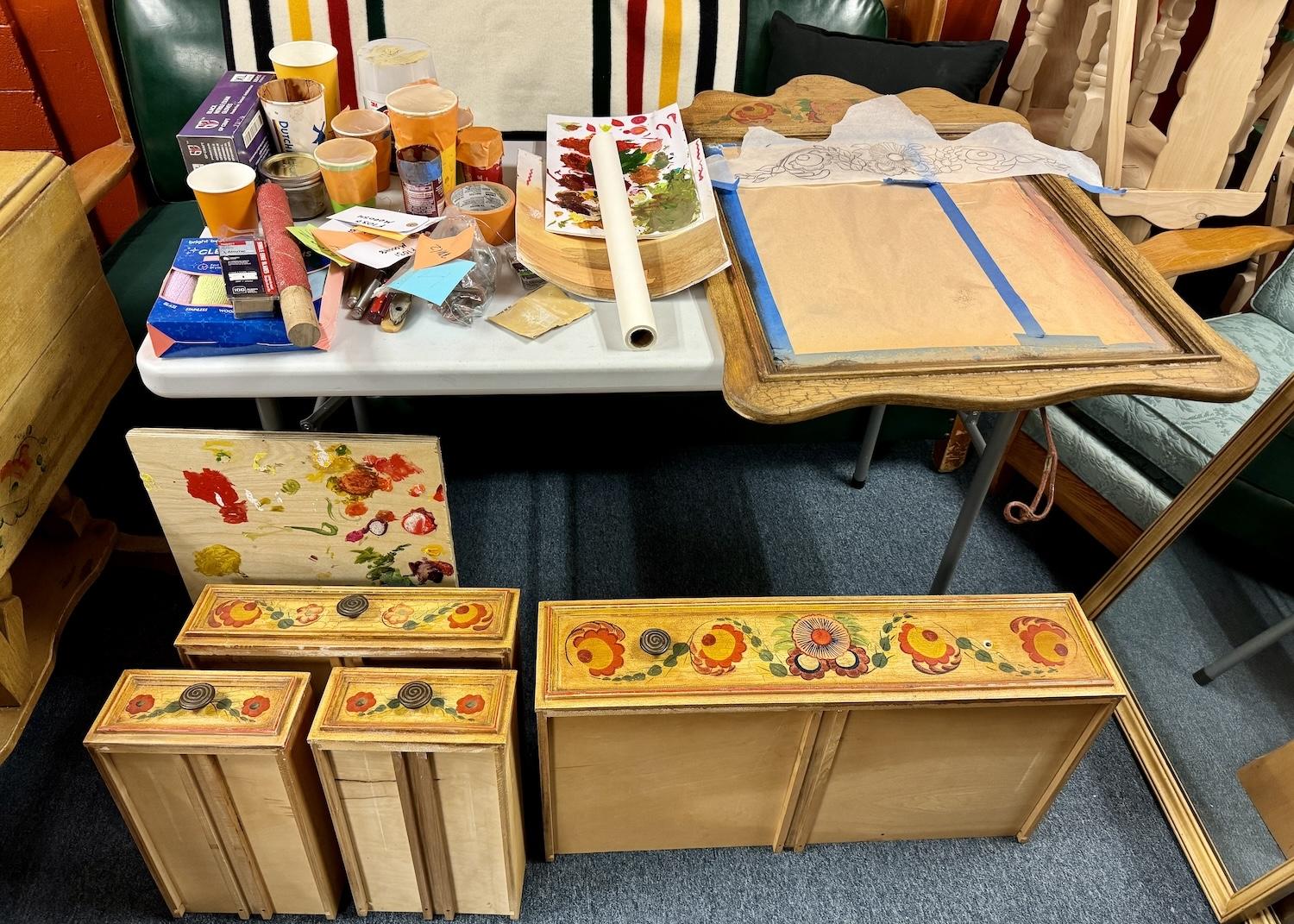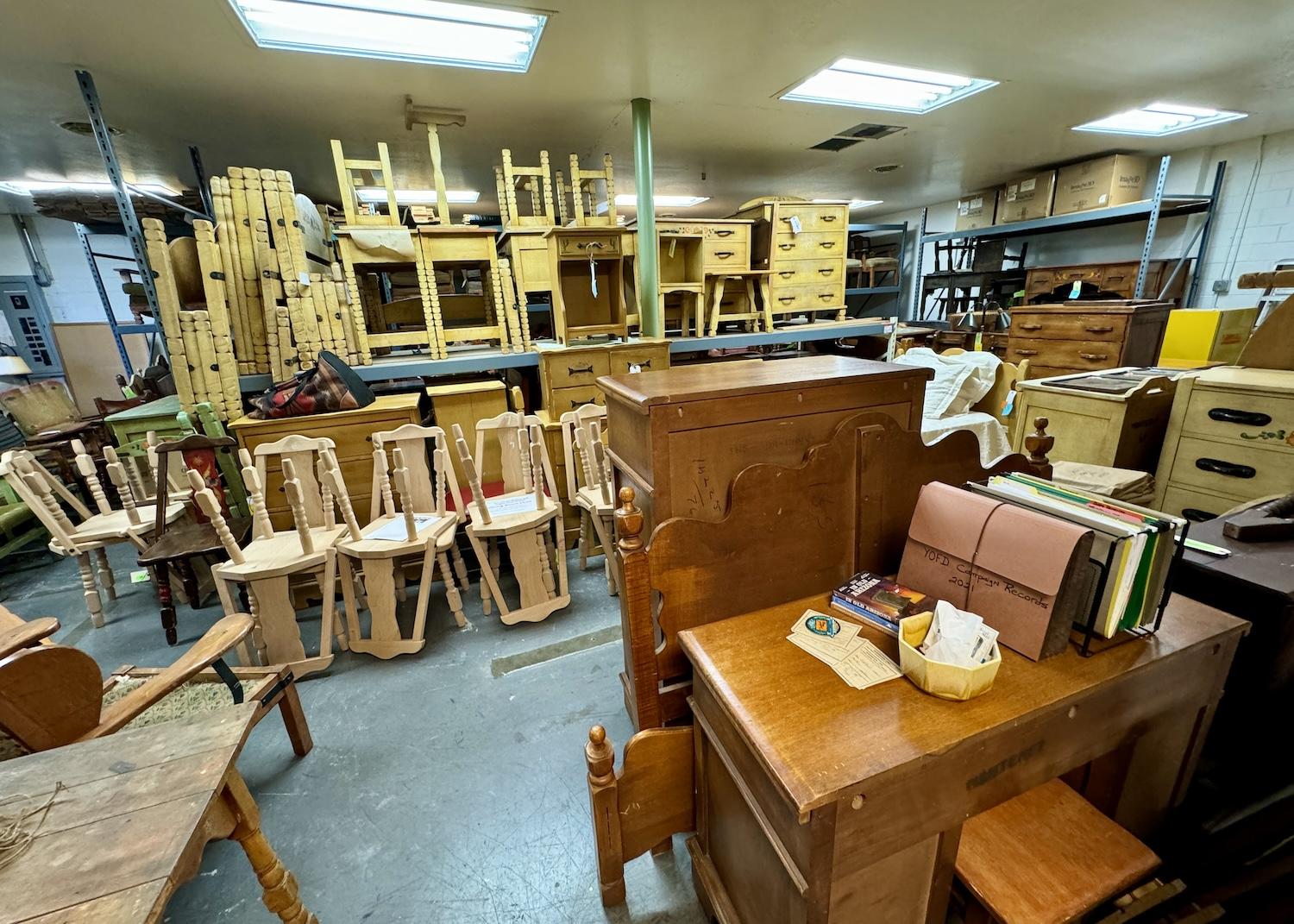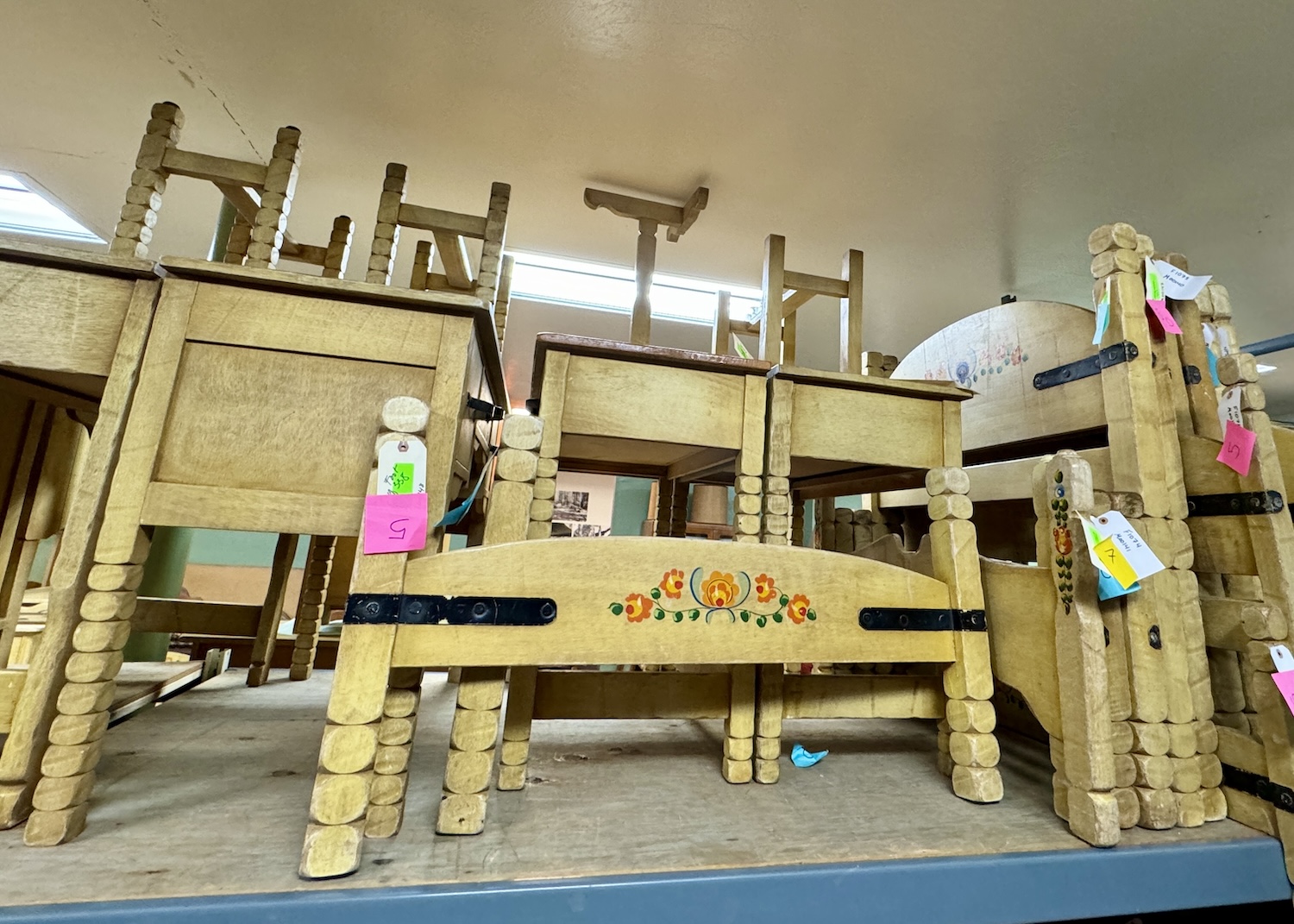It has been said that “a room full of Monterey furniture always seems to have a sense of humor about it.” The pieces in this storage room in Grants Pass, Oregon are clearly having a grand old time while off-duty and jammed into their temporary home.
Beds are disassembled. Armchairs are stacked on shelves. Mirrors lean against each other. Whimsical floral and Mexican motifs hand-painted on wood are refusing to fade completely away. Headboards are unabashedly chipped. Desks are gleefully scratched.
But as the 240 original pieces of furniture that belong to the Oregon Caves National Monument & Preserve mix with the 150 pieces that have been donated to the Friends of the Oregon Caves and Chateau, they have one thing in common. They’re all slated to be lovingly restored and returned to the Chateau, a six-story, 25-room lodge built during the Great Depression in a canyon beside a marble cave.

Sue Densmore, executive director of the Friends of the Oregon Caves and Chateau, shows off her Grants Pass office full of Monterey furniture. Most is owned by the NPS and some has been donated to the Friends/Jennifer Bain
“There willl be a chest of drawers, a desk/vanity, bed, night stand and chair in each room,” says Sue Densmore, executive director of the friends group that’s fundraising for this ambitious project. “We’re trying to bring it back to where it’s comfortable, cozy and fun. We feel like if we properly restore the furniture collection, we’ll have people come just to see that.”
It’s a safe bet.
As the National Park Service explains in the monument’s foundation document, “the architecturally significant Chateau includes the largest publicly owned collection of Monterey furniture, one of two styles that are purely American.” For some visitors, that’s even more exciting than the “marble halls of Oregon” themselves.

Closed for rehabilitation work since 2018, the Oregon Caves Chateau was built in 1934 in rustic "Parkitecture" style and clad in bark siding from Oregon cedar trees/Jennifer Bain
When I visited in September, the Chateau had already been closed for six years for a large-scale rehabilitation project that took it down to its studs and, unfortunately, revealed expensive foundation and seismic issues.
Cave tours run until November 3, but the Monterey furniture isn’t on display, the dining room with a creek that runs through it is closed, the 1930s-style diner isn’t making its famous milkshakes, and there’s nowhere to sleep near the caves except the small Cave Creek Campground four miles away that’s already closed for the season.
In 2018, 67,417 people still managed to visit, even with the Chateau closing weeks before the season ended. Last year, that number was just 32,041. The pandemic can take some blame. But losing overnight visitors has been a big blow to a small unit that struggles for attention in the shadow of Crater Lake National Park.

Stalactites and other natural wonders await you on a ranger-led tour of Oregon Caves/Jennifer Bain
Here in southwest Oregon’s Siskiyou Mountains, what the Park Service describes as a dynamic system of marble caves with limestone formations started forming 330,000 years ago through calcium carbonate deposition.
A local named Elijah Davidson stumbled upon the natural wonder in 1874 while chasing his dog Bruno during a hunting trip. With only matches for light, he waded through an underground stream and eventually emerged into daylight and was reunited with Bruno.
News spread and the cave — considered a wet cave because the River Styx runs through it — was quickly monetized. Early visitors came on foot and horseback before a road was built in 1922, breaking off pieces of the caves as souvenirs and writing their names on the walls before anyone knew better.

Oregon Caves ranger Greg Sosnicki prepares to take a small group into the marble caves in September/Jennifer Bain
“Over the years, the sometimes odd, grotesque, beautiful, and fantastic stone formations were given names like the Garden of the Gods, Paradise Lost, Neptune’s Grotto, Joaquin Miller’s Chapel, Ghost Chamber, and Satan’s Cradle in order to excite potential visitors about traveling to the area and taking a tour of the cave,” the Friends note in their new book, Images of America: Oregon Caves National Monument and Preserve.
President William Howard Taft set aside 480 acres for protection as a national monument in 1909. In 2014, a 4,070-acre national preserve was added to include the surrounding watershed and forest and so there are now six hiking trails. In between these dates, the Grants Pass business community stepped in during the Depression to help stimulate the economy.
“Built by local investors in 1934, a luxury hotel with a welcoming lobby, indoor plumbing, and private rooms was needed to attract those who could afford to travel in their private automobiles, seeking luxury while adventuring in nature,” writes Restore Oregon’s executive director, Nicole Possert, in FieldNotes Magazine.

A vintage postcard shows well-heeled guests arriving at the Chateau by car in the 1930s/Friends of the Oregon Caves Collection
The Chateau, as envisioned by landscape architect Arthur Peck, was designed by Grants Pass carpenter Gust Lium. “They call it 'Parkitecture,' which means that it looks like it grew up out of the ground,” Densmore explains.
Perched in a steep canyon next to the cave’s entrance and crossing a woodland ravine, the hotel used Port Orford cedar bark siding and marble from the cave to blend in with its surroundings.
There were wooden balconies with forest views and a grand, two-sided stone fireplace in the lobby. Cave Creek was diverted to be a small waterfall that feeds a concrete pond outside the Chateau. Inside, Lium engineered a conduit to route the stream through the dining room.

A vintage photo of the Chateau's lobby, complete with Monterey furniture, sits in front of the stone fireplace during construction/Jennifer Bain
“We’re not really sure why the Oregon Caves has Monterey furniture,” Densmore admits on a private tour of the shuttered hotel. “Mason Manufacturing was trying to find a market and they were testing things to see who was going to buy it.”
This much is known — the moderately priced furniture was ordered from regional department store Meier & Frank in Portland in 1933. It stayed in place here until 2018 when the Chateau was closed and it was moved 50 miles away to Grants Pass for safekeeping at the Friends' headquarters.
“What is it about this California Depression-era furniture that has given it such an enduring appeal and why is Monterey furniture attracting so much attention now?” ask the authors of Monterey: Furnishings of California’s Spanish Revival. (They're the folks who said a room full of Monterey originals has a sense of humor about it.)

Hollywood stars went mad for California-made Monterey furniture when it first appeared in 1929/Jennifer Bain
Monterey was the first production furniture style that California could call its own. Hollywood heavyweights Bela Lugosi, Will Rogers, Gene Autry, Walt Disney and Clark Gable embraced it back then. Diane Keaton, known for quirky comic roles and impeccable style, loves it now.
The line was created by Frank Mason and his son George of the Mason Manufacturing Co. in Los Angeles. The men credit L.A. furniture company Barker Brothers with showing them a photo of a settee in the 1928 Warner Baxter film In Old Arizona as inspiration for a furniture line to go with the Spanish-style homes that were popping up everywhere.
They came up with a rustic style that used Oregon alder, rope, wrought iron accents, painted wildflowers and a little upholstery. Their hand-crafted bedroom sets, dining rooms sets, upholstery pieces, end tables, coffee tables, desks and secretaries, home bars and stools, lamps and novelty items were only made from 1929 to 1942.

Many, but not all, pieces of Monterey furniture were branded with a horseshoe and the name of the line/Jennifer Bain
A sure sign of authenticity is the logo of a horseshoe burned into the wood, sometimes alongside the word Monterey. But when the branding iron smoke bothered factory employees, some pieces were apparently shipped out unbranded.
Another signature touch is the animated artwork of Juan Duran Tinoco (Juan Intenoche) who walked into the factory looking for work and rose to painting department foreman. He was actually a famous cartoonist from Mexico City who added comical depictions of vaqueros (cowboys), donkeys, cactus and sombreros to the wooden furniture.
With artisans given such creative license, very few Monterey pieces are exactly the same. “We had a lot of fun making up this line,” the late George Mason once said.

Mexican cartoonist Juan Duran Tinoco (Juan Intenoche) painted floral and Mexican motifs into Monterey furniture/Jennifer Bain
Historians break down the Monterey line into five stages, the most prized being the Classic Period from 1929 to 1932, while the Chateau’s pieces came from the Transitional Period of 1932-33 when orange became a popular paint color. Manufacturing stopped as America’s tastes changed, Frank died and George joined the Navy.
The furniture fell out of style for decades until people started seeking it out in thrift shops and second-hand stores. Now it’s prized by collectors. Back in Oregon, the concessionaire running the Chateau didn’t replace the aging furniture like most hotels do.
There was an upside to this “era of neglect.” Having original furniture helped the Chateau earn National Historic Landmark status in 1987 and the collection now belongs to the NPS.

The upholstery on many handcrafted Monterey pieces has held up well given the wear and tear it endured at the Chateau/Jennifer Bain
It's in remarkable condition. Some upholstery needs to be replaced and some designs have faded or been altered. But once the restoration is complete, the NPS says the Chateau will be the only lodge in the National Park System with its original furniture (and of course those originals will be complemented by donated pieces). Visitors will once again be welcome to stay overnight, or just wander in to admire the building and its storied furniture or have something to eat or drink.
The Friends are now working with Los Angeles woodworker Ramon Ramirez, who has curated and restored Keaton’s private collection and created new Monterey-style pieces for her.
“He’s adorable and extremely talented,” says Densmore, “and it’s been his life’s work to restore this crazy furniture made for movie stars and only made for 14 years.”

All of the guest rooms at the Oregon Caves Chateau are being reconfigured/Jennifer Bain
Of course, the ambitious Chateau project hinges on money.
The NPS is working on funding its “critical life, health and safety rehabilitation” that will tackle, among other things, fire safety issues and boost access for people with mobility issues by adding handrails, accessible restrooms and an elevator.
The Friends hope to raise $15 million and ask the state for another $15 million. Restore Oregon has already helped them secure a state grant to restore 97 interior and exterior doors with original hardware. Funding to restore three balconies has also been secured.

A creek (technically water from a diverted creek) will one day run through the Oregon Caves Chateau dining room again/Jennifer Bain
There is even money to connect twin beds and make king-sized sleeping spaces since, as Densmore puts it, “we are aware that the average traveler doesn’t want to sleep on an old bed that isn’t going to get you through the night.” There should be 25 guest rooms again. Two were commandeered to connect with fire escapes, so there have only been 23 for several decades.
The creek will eventually flow once again through the dining room.
Furniture donations are pouring in to that storage room/restoration workshop space in Grants Pass, and the Friends hope to work with the Portland-based Pendleton Woolen Mills to develop blankets and other items to complement the Monterey furnishings.

Fading artwork on wooden Monterey furniture pieces will be painstakenly restored at the Friends headquaters/office in Grants Pass/Jennifer Bain
“The Chateau is a crazy, creative place,” says Densmore. “It’s just magical.”
She dreams of a future where the park, about 20 miles from tiny Cave Junction along a seriously steep and winding road, draws 200,000 visitors a year and doesn’t have to close in winter.
“It’s always 44 degrees in the cave,” she points out before we bundle up for a ranger-led tour, decontaminating my boots (worn in other caves and mines) to protect bats from deadly white-nose syndrome. It's on this tour that I learn why Oregon Caves is the birthplace of the View-Master.

Not many people realize that Oregon Caves is credited as the birthplace of the View-Master/Jennifer Bain
Back in 1938, Oregon inventor/photographer William Gruber took a cave tour with two cameras strapped together on a tripod and happened to meet postcard publisher Harold Graves of Sawyer’s Photo Finishing Service.
Over dinner at the Chateau, the photo buffs transformed the idea into what we know as the View-Master. Their 3D viewing device debuted at New York’s World Fair as an alternative to scenic postcards and was a hit. Produced at first by Sawyer’s, the View-Master is now made by Mattel. There’s an interpretive sign about it outside the Chateau.

When the red stools in this 1930s diner at the Chateau were put up for sale by a concessionaire, the Friends of the Oregon Caves and Chateau stepped in. Visitors have long loved the diner's milkshakes/Jennifer Bain
On that private tour of the Chateau, the building is a construction zone. Who will run it when it eventually reopens is unknown, but Densmore reminisces about the turmoil that ensued when a departing concessionaire tried to sell the furnishings. The Friends quickly ponied up for the check-in counter, a vintage phone booth and treasured red stools from the the coffeeshop (also known as the diner).
Then there was that time just before Christmas 1964 when snowfall followed by warm rain triggered a flood that swept all the A-frame dining room chairs down the canyon. Naturally, the Friends had a fundraiser for that. Wayne Tarris and John Jory from the Siskiyou Woodcraft Guild have made replicas and people can now sponsor chairs and have personalized plaques put on them. “We want people to get invested in it,” Densmore explains. “Monterey is a concept is what Ramon says. So to take it forward, we decided let’s have some fun with it.”
No doubt the Masons would be pleased.

To help the Friends of the Oregon Caves and Chateau fundraise, people can sponsor replica dining chairs (shown on the floor in the center of this photo)/Jennifer Bain



 Support Essential Coverage of Essential Places
Support Essential Coverage of Essential Places




Comments
I have stayed at the Cave a couple of different times... decades apart... The first time was in the mid 1970's & there were CABINS located on the area above the cave site. They were the least expensive option &, if memory serves correctly, I believe there was a separate shower building but you had a sink in the room... &I think the toilets were in another building. We were too broke to afford a room in the Chateau. But we did splurge on a trout dinner in the "fancy" dining room. Then almost 40 yrs later I did stay in the Chateau building & I am very glad to hear that they are going to get new beds! The room was very sweet but noisy (no sound dampening insulation in the old days) & the bed left much to be desired. But, I had made it to the "fancy" accommodations at last. And, of course, the cabins are long gone. Ironically there were also cabins at Crater Lake... and in the 70's they were the cheapest accomodations there so, of course, that is where we stayed. Those were pretty deluxe because you had your own toilet and sink... but the showers were in another building. And, like with the Chateau,a few decades later, we got to stay in the Crater Lake Lodge itself... in a deluxe room with Lake views. Thanks to the Scotts' great guide to Park Lodges, we got a wonderful room. I am sorry that the lower priced accommodations at both places are no longer available as we all know the lodging in the Monuments and Parks is very pricey and many regular folks cannot afford such costs. Anyhow, thank you for the nice story about such a wonderful place!